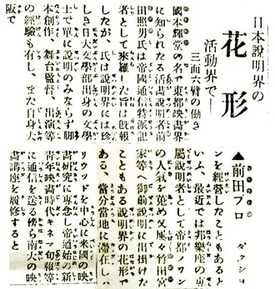
When talking about the history of Japanese language broadcasting in Los Angeles, there is one person who cannot be left out. That person is Kawabe Teruo, who stayed in the United States for about nine years from 1929 and served as an announcer for various programs. However, even for those who lived at the time, it seems that very few people would know who Kawabe Teruo was. This is because in public he did not use his real name, Kawabe, but instead used the names Maeda Teruo, Maeda Teruo, or Kunimoto Terudo.
Let's start with a brief history of Kawabe. Born in Oita Prefecture in 1899 (Meiji 32), while a student at Nihon University, he made his debut as a silent film narrator at the Aoyama-kan, calling himself an "enthusiastic narrator" under the name Kunimoto Kido. He then worked as a narrator specializing in foreign films at the Akasaka Teikoku-kan, Shinjuku Musashino-kan, Marunouchi Hogaku-za, and other venues. At the Toyo Kinema in Kanda, he performed alongside such popular narrators as Tokugawa Musei, Otsuji Shiro, and Matsuda Suisei. He also started producing films, writing the original story for "Song of the Fallen Leaves," and starring in and producing "Tired of Walking" and "Overture to Youth" by Maeda Film Productions.

He traveled to the United States in April 1929 as a correspondent for the Teikoku Tsushinsha (Imperial Press Agency). Shortly after arriving in Los Angeles, he visited the Rafu Shimpo newspaper and, identifying himself as the narrator Kunimoto Terudo, said that his purpose in coming to the United States was to study film technology at the University of Southern California.
In August 1955, he became a reporter for the Rafu Shimpo newspaper, calling himself Maeda Teruo, and worked as a narrator at film events organized by the newspaper. In August 1957, he transferred to Rafu Nichibei, and in September 1961, he worked as a reporter at the Southern California branch of the Shinsekai Shimbun. Soon after, he resumed the name Maeda Teruo, which he had used when he first came to America.

As for his professional film career, he made his American debut as a narrator with his own film, "Tired of Walking," screened at Fujikan in August 1929. In 1934, he became an exclusive narrator at Fujikan, which specialized in screening Japanese films, but from April of the following year, all films shown at the theater became talkies, and he was fired. After that, he continued his work as a narrator, touring screenings around the Midwest.
In terms of film production, his involvement in "Age of Trouble" (1929, screenplay and starring role), the first Japanese-language talkie in America, "The Power to Turn the Earth's Axis" (1930, screenplay), a joint production by the Issei and Nisei, "New Film" (1935, director), and the Seirin Film Study Group's "The Growing Second Generation" (filming began in April 1936).
Now, on to the main topic of Japanese broadcasting, Kawabe's radio career is as follows: After making his debut in June 1930 with "Japanese Broadcasting Station" hosted by Kawachi Kazumasa, Kawabe succeeded Kanda Koichi as announcer. He then acted as announcer for the Rafu Japanese Association Broadcasting, which began in December 1931, and for a solo program featuring Sugimachi Miyoshi (soprano) hosted by dentist Dr. Cohen in February 1932. With his broadcasting experience, he became an executive of the Japan Cultural Broadcasting Corporation, which began in September of the same year, and in addition to announcing, he was actively involved in Movie Story, radio dramas (performing and directing), and advertising, supporting the backbone of the Broadcasting Corporation as the right-hand man of the host.
In this way, he could be called a living dictionary from the dawn of Japanese broadcasting. Incidentally, he first used the name Teruo Kawabe in April 1936 when he was in charge of producing a radio drama that was submitted to the public. To many listeners, he may have seemed like a new face.
"Maeda is a gentle man with a pale face, who also worked as a newspaper reporter and whose crisp Edo dialect is perfect for broadcasting; his tone must still ring in people's ears" (Fujioka Shiro, "Traces of Abu: The Story of the Japanese Colonization of the North American Continent"), and one can see why he was so highly sought after in the Japanese broadcasting world. Incidentally, there are also examples of silent film narrators becoming Japanese broadcast announcers in Brazil and Canada.
Having thus left a significant mark on the Japanese community in the fields of radio and film, Kawabe returned to his home country in 1938. He was said to be teaching film technology at his alma mater, Nihon University, but apart from his contributions to film magazines, very little is known about his activities after his return.
*This article is an excerpt from Japan Hour (2020) and reprinted from The Rafu Shimpo (April 27, 2021).
© 2022 Tetuya Hirahara







